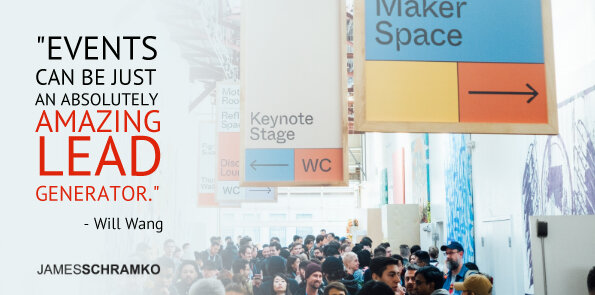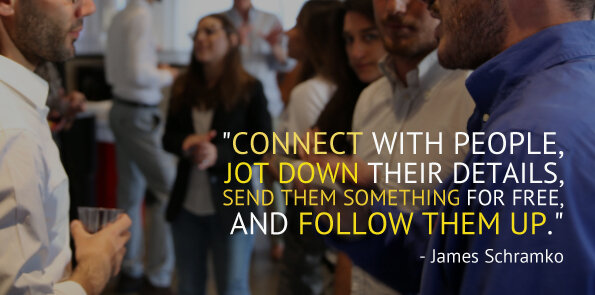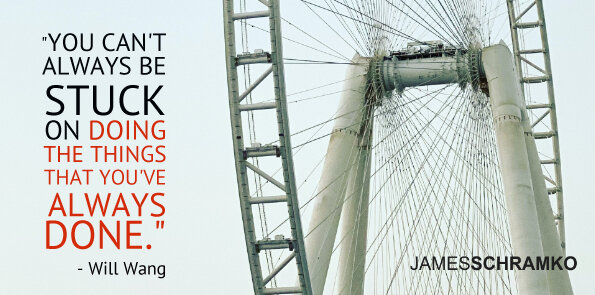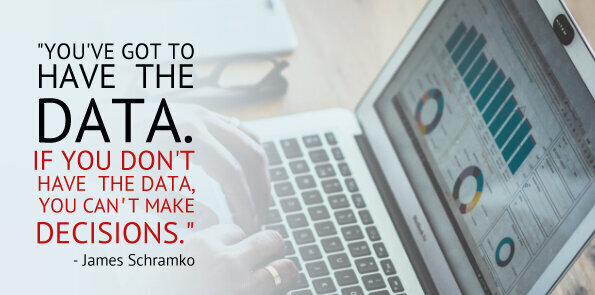Podcast: Download (Duration: 36:02 — 33.8MB)
Get Notified Of Future Episodes Apple Podcasts | Spotify | Amazon Music | Android | Blubrry | Gaana | TuneIn | Deezer | Anghami | RSS | More
Regardless of business model, a company needs leads that become customers. Lead gen is Will Wang’s specialty, and in this appearance he and James go over what they consider the top five tactics for acquiring quality leads.
They talk about combining the live event with cold email outreach as a powerful lead generation solution.
They go into the role of speaking as a way to generate new leads.
And they discuss the importance of innovation and updating your lead generation techniques.
Table of contents:
1. 1 – Leveraging those events
2. 2 – Taking a speaking role
3. 3 – Partnering up with someone
4. 4 – Innovating and changing strategy
5. 5 – Getting the most out of content
6. Summing it up
1 – Leveraging those events
As the first lead generation tactic, our experts look at the strategic use of events. Rather than just attending events, sponsoring, or exhibiting, Will asserts that businesses should identify their ideal clients or leads and use events as an opportunity to reach out to them.
He highlights the importance of not merely showing up, but arranging to meet prospects before, during, and after an event.
Will outlines a successful strategy he has implemented with his clients:
1. Identifying events attended by their “dream clients”.
2. Creating a list of potential contacts (not necessarily event attendees). And
3. Reaching out to them via cold emails to arrange meetups before the event.
This proactive approach allows businesses to be more targeted and strategic in their event participation.
Will emphasizes the importance of writing compelling emails that achieve high open and reply rates. These cold emails serve to initiate conversations, qualify potential leads, and set up meetings before events.
James has plenty of personal experience using events and social networks to engage with potential customers. He can vouch for the effectiveness of direct messaging and face-to-face interaction during events.
James also emphasizes the need for pre-event engagement and post-event follow-ups. There’s great value, he says, in personally connecting with clients and leveraging common interests to facilitate deeper business discussions.
The lead-generating potential of events is growing in the post-pandemic era. Events, says Will, have become the best lead generators for his business.
James can tell of encounters at events that have turned into long-lasting business relationships. To achieve this, he highlights a strategy of identifying potential clients’ challenges, offering valuable resources, and initiating follow-ups after the event.
2 – Taking a speaking role
The second lead-generation move Will recommends is taking on speaking roles, such as going on stage at events, or speaking on podcasts, as a powerful way to share knowledge and establish authority.
Will does acknowledge that speaking opportunities may not be immediate, especially for those who are new to public speaking. He suggests paying to sponsor events and getting a spot on stage, or building up gradually by starting with smaller stages to hone presentation skills.
Over time, with a track record of successful speaking engagements, it becomes easier to secure larger platforms.
James agrees, sharing his personal experience with public speaking. He started with small-scale presentations at Mercedes-Benz and gradually shifted into larger settings, like business chambers, conferences, and events overseas.
James’s journey in public speaking also helped him start his business. He believes that speaking at events boosts credibility and trust, which can significantly increase conversion rates, even though the audience size might be smaller compared to online methods.
The real leverage though, says James, comes not just from the audience, but from connections with other speakers. Building relationships with co-speakers can lead to collaborations or invitations to speak at their events, thereby reaching new audiences and expanding one’s influence.
As an added tip, James mentions Ezra Firestone‘s strategy at no-pitch events. Ezra would invite attendees to approach him after his talk for one-on-one conversation. This allowed him to connect with hundreds of people and offer immediate value while building strong rapport.
James believes this approach is excellent for maximizing public speaking opportunities, and encourages others to try the same.
3 – Partnering up with someone
Tactic three, says Will, is forming strategic partnerships.
This actually builds on number two – every speaking engagement, he argues, presents an opportunity to meet someone who operates in a similar space or serves a similar clientele. Such connections often lead to valuable partnerships.
Will had the experience of speaking at an SEO event, where he fostered partnerships with a LinkedIn expert and an event organizer, despite not being an SEO specialist himself. Striking up conversations with other attendees or speakers, he says, can lead to partnerships that transform businesses.
If someone isn’t frequently speaking at events, Will and James suggest seeking partnerships in other ways. For instance, by reaching out to businesses serving similar customers.
This approach not only opens up new business opportunities but also allows you to borrow the authority of the partner you’re working with, thereby adding credibility to your brand or service.
James relates this to his own partnership with Will and how it grew. He also highlights his partnership with Kleq, where the founder intentionally sought him out for potential collaboration.
It’s important, says James, to be open to opportunities and actively seek them out, whether through cold emails or speaking engagements. He further suggests that you may need to take risks with potential partners and experience some unsuccessful tries before finding the right fit.
4 – Innovating and changing strategy
The fourth tactic involves innovation and changes in strategy as crucial for businesses. This entails a shift in perspective and keeping on top of things as markets and industries evolve.
Will shares his experience with the tech industry, which saw a considerable downturn, leading to fewer clients and reduced budgets. To address this, he and his team had to pivot, reassess their focus, and seek opportunity in other industries such as professional services.
Will underscores the need to be flexible and adaptable in one’s approach, which James reaffirms. Complacency is dangerous, says James, and he stresses the role of good data in making informed decisions, and adjusting strategies as needed.
James also speaks of his personal commitment to constant adaptation and evolution. As a salesperson, he says, it was important to recognize one’s core competence (the “engine”) and find new ways to apply it (the “vehicle”) when existing methods weren’t producing desired results.
This approach, says James, is especially crucial in the face of emerging technological shifts. It doesn’t mean an overhaul of your entire business, but rather applying existing skills and expertise in a new direction or to a different target audience.
An example is Will’s recent return to one-to-one coaching, specifically for small B2B business owners who need help with lead generation. It’s a service he previously offered, but targeted now at a specific niche that he can serve effectively.
5 – Getting the most out of content
The final item in our experts’ list is leveraging content as a key lead generation tactic.
Will points to the value of using high-quality content to connect with and reach out to people.
Despite initial doubts about LinkedIn, with its restrictions and spam, Will and his team have found success using the platform for this strategy.
The content acts as a medium for thought leadership, attracting people who resonate with it and initiating conversations.
Will and James have observed that even indirect leads can be beneficial. They’ve found success in engaging with users who interact with their content, asking them why they liked it and who else might be interested.
This strategy has often led to referrals, which have proven valuable in the past. In fact, Will has begun developing a system around this approach that involves increasing the amount of content and outreach.
Will and his team engage with users both within and outside of LinkedIn, building email lists from LinkedIn connections for more personalized outreach.
This method may seem simple and obvious, says James, but it’s often overlooked. Many content creators are so absorbed in producing new material that they fail to engage with those who respond to their existing content.
James suggests a balance between creating and promoting content – he’s seen many successful people who split their time equally between these tasks.
It’s important, however, to choose a platform that aligns with your target audience and personal preference.
James leans towards Instagram, where he has frequent interactions with his followers, who are mostly individual smaller businesses. He maintains two accounts: one for surfing, and a personal one.
Will’s clientele, on the other hand, mostly consists of employed individuals, making LinkedIn the more suitable platform for him.
So to maximize the effectiveness of your content leverage strategy, choose a platform you’re comfortable with, and where your target audience is present.
Summing it up
In summary, the top five lead generation tactics for businesses are:
1. Leveraging events by contacting potential prospects and arranging to meet them before, during, and after an event.
2. Establishing authority through speaking engagements, whether at physical events or on podcasts, to drive conversions and target the right audience.
3. Partnerships as a key to boosting business, essentially taking advantage of other people’s resources without any conflict of interest.
4. Innovating and changing strategy as dictated by needs and changes in the market and in circumstance.
5. Content leverage. If you’re an organic content marketer, it’s essential to harness the energy you create and engage in conversations. By following and interacting with people who have your target clients, you can fine-tune your material and strategically increase your visibility.
If you liked this discussion and would like one-to-one coaching on lead generation, look up Will at growthlabz.com.
Liked the show? Leave us a review on iTunes













Leave a Reply